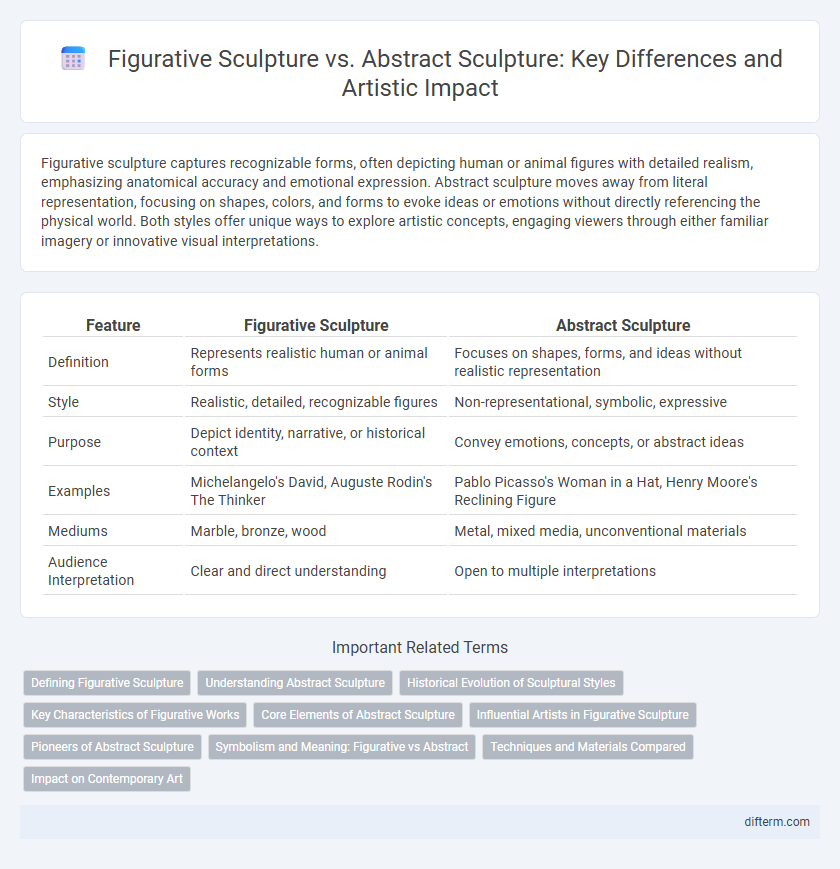Figurative sculpture captures recognizable forms, often depicting human or animal figures with detailed realism, emphasizing anatomical accuracy and emotional expression. Abstract sculpture moves away from literal representation, focusing on shapes, colors, and forms to evoke ideas or emotions without directly referencing the physical world. Both styles offer unique ways to explore artistic concepts, engaging viewers through either familiar imagery or innovative visual interpretations.
Table of Comparison
| Feature | Figurative Sculpture | Abstract Sculpture |
|---|---|---|
| Definition | Represents realistic human or animal forms | Focuses on shapes, forms, and ideas without realistic representation |
| Style | Realistic, detailed, recognizable figures | Non-representational, symbolic, expressive |
| Purpose | Depict identity, narrative, or historical context | Convey emotions, concepts, or abstract ideas |
| Examples | Michelangelo's David, Auguste Rodin's The Thinker | Pablo Picasso's Woman in a Hat, Henry Moore's Reclining Figure |
| Mediums | Marble, bronze, wood | Metal, mixed media, unconventional materials |
| Audience Interpretation | Clear and direct understanding | Open to multiple interpretations |
Defining Figurative Sculpture
Figurative sculpture represents human and animal forms with a focus on realistic detail and recognizable shapes, capturing physical likeness and emotional expression. It emphasizes anatomical accuracy, proportion, and narrative elements rooted in historical and cultural contexts. Unlike abstract sculpture, figurative works maintain identifiable subjects, making them accessible and relatable to a broad audience.
Understanding Abstract Sculpture
Abstract sculpture emphasizes form, texture, and materials over realistic representation, inviting viewers to interpret meaning through shapes and spatial relationships. Unlike figurative sculpture that depicts recognizable subjects, abstract pieces challenge traditional perceptions by prioritizing emotional expression and conceptual ideas. Mastery of abstract sculpture requires an understanding of composition, balance, and the artist's intention beyond literal interpretation.
Historical Evolution of Sculptural Styles
Figurative sculpture, rooted in ancient civilizations such as Mesopotamia and Ancient Greece, emphasizes realistic representation of the human form and narrative themes. Abstract sculpture emerged in the early 20th century, influenced by Modernist movements like Cubism and Futurism, prioritizing non-representational forms and emotional expression. This evolution marks a shift from traditional realism to experimental forms, reflecting broader cultural and philosophical changes in art history.
Key Characteristics of Figurative Works
Figurative sculpture emphasizes realistic representation of the human form or recognizable subjects, focusing on anatomy, expressions, and detailed textures to convey emotion and narrative. It often uses traditional materials like marble, bronze, or wood to create lifelike proportions and poses that resonate with viewers. This style contrasts with abstract sculpture by maintaining clear references to real-world figures and stories, prioritizing visual accuracy over interpretive forms.
Core Elements of Abstract Sculpture
Abstract sculpture emphasizes form, texture, and space over realistic representation, using non-representational shapes to evoke emotions and ideas. It prioritizes materials and surface treatments, exploring volume and movement without relying on recognizable figures or narratives. Core elements include geometric or organic forms, dynamic balance, and the interaction between solid and void to create a sensory experience.
Influential Artists in Figurative Sculpture
Influential artists in figurative sculpture include Auguste Rodin, whose expressive works like The Thinker emphasize the human form's emotional depth and physical realism. Camille Claudel contributed significantly with her dynamic, delicate portrayals of human figures, blending naturalism and personal narrative. Contemporary sculptors such as Duane Hanson continue this tradition, creating lifelike, socially reflective human forms that challenge viewers' perceptions.
Pioneers of Abstract Sculpture
Pioneers of abstract sculpture, such as Constantin Brancusi and Henry Moore, revolutionized the art form by emphasizing simplified, geometric shapes that evoke emotion rather than replicate reality. Their innovative approaches challenged traditional figurative sculpture, which focuses on realistic representations of the human form or animals. These artists laid the groundwork for modern sculpture, influencing generations with works that explore form, space, and abstraction.
Symbolism and Meaning: Figurative vs Abstract
Figurative sculpture conveys symbolism through identifiable human or animal forms, often representing specific narratives, emotions, or cultural archetypes that connect directly with viewers' experiences. Abstract sculpture employs non-representational shapes and forms to evoke emotions and ideas, relying on interpretation and subjective meaning rather than literal depiction. Symbolism in figurative sculpture is anchored in recognizable imagery, while abstract sculpture's meaning emerges from form, texture, and spatial relationships.
Techniques and Materials Compared
Figurative sculpture employs traditional techniques such as carving, modeling, and casting to represent recognizable human or animal forms, often using materials like marble, bronze, and clay. Abstract sculpture emphasizes innovative methods including welding, assemblage, and mixed media, utilizing diverse materials such as metal, glass, and found objects to convey conceptual ideas. The contrast in techniques and materials reflects the distinct artistic intentions between representational accuracy in figurative art and expressive freedom in abstract sculpture.
Impact on Contemporary Art
Figurative sculpture, with its focus on realistic human forms and narrative detail, continues to influence contemporary art by emphasizing storytelling and emotional connection. Abstract sculpture challenges traditional representation, encouraging experimentation with shapes, materials, and spatial dynamics that redefine viewer interaction. Both forms drive innovation by balancing historical techniques with modern conceptual exploration.
Figurative Sculpture vs Abstract Sculpture Infographic

 difterm.com
difterm.com